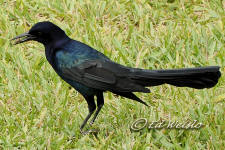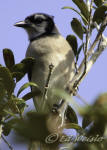Birds of Florida
Passerine / Ground Dwelling
Common Grackle, Boat-tailed Grackle, Florida Scrub Jay, Blue Jay, Northern Cardinal, Eastern Bluebird, Mourning Dove, Wild Turkey, American Crow
Common Grackle - Quiscalus quiscula
Family - Icteridae

In a behavior called "anting" grackles will stand with their wings spread, letting ants crawl on their body and feathers. It is believed that the formic acid the ants secrete helps rid the birds of parasites.
The Common Grackle is a large blackbird with an 11 to 13 inch body length and 18 inch wingspan.
Appearing solid black from a distance, adult male Common Grackles are black with iridescent blue, purple and bronze, females are dull brown overall with less iridescence than males, juvenile birds are brown. Adults have a bright golden yellow eye, immature birds have dark eyes.
The Common Grackle congregates in large flocks, often mixed with other blackbirds, tarlings and cowbirds.
Diet consists of grains, nuts, seeds, fruit, insects, fish, frogs, birds, and just about anything else including garbage. Prefers open areas and forages on the ground.
Because they form such large flocks the Common Grackle causes serious damage to agricultural crops and has actually expanded its range to follow agriculture in the United States.
Boat-tailed Grackle - Quiscalus major
Family - Icteridae

Boat-tailed Grackles nest in dense vegetation, often over or close to water.
Male Boat-tailed Grackles are 10 to 14 1/2 inches long with a wingspan just under 20 inches, they are a shiny iridescent purple-black overall with a more greenish hue on the wings and tail.
The female is 1/2 the size of the male, back and head is a dark cinnamon brown, breast and underside is lighter brown to buff colored, immature birds are colored like female with a streaked underside and breast. Adult eye color varies from straw yellow to dark.
Ground forager, diet consists of fruits, grains, acorns, other seeds as well as small invertebrates such as frogs.
Boat-tailed Grackle habitat includes marshes and open uplands as well as agricultural lands.
Florida Scrub Jay - Aphelocoma coerulescens
Family - Corvidae


Florida Scrub-Jays are a robin sized bird with a length of 9-11 inches and a wing span of 13-14 inches. Color is a dull blue overall with a whitish forehead and a pale gray back and belly, juveniles are grayer overall than adults and lack the blue head of adult Jays.
Scrub-Jay family groups will take turns watching for danger while the others feed on insects, berries and seeds, they love acorns and one adult may cache thousands of them throughout the fall season. Florida Scrub-Jays are reluctant to fly across non-oak-scrub habitat and rarely stray from the area where they hatched. Young birds stay with their parents until they can obtain a territory of their own. Until then, they help their parents feed their siblings, keep watch for predators, and defend the territory year-round. These family groups are generally composed of adults and up to 6 offspring
The Florida Scrub-Jay is federally listed as a threatened species and it is endemic to the state of Florida, they are found nowhere else in the world. One of 15 species of Jay native to North America, it is the only bird species that lives exclusively in Florida. Scrub-Jay populations are in decline (current population estimates 4,000 breeding adults) because of the loss and fragmentation of habitat - sandy, low growing scrub oak and open scrubby flatwoods necessary for their survival.
Fire suppression in previous years has also allowed some former Scrub-Jay habitat to become so overgrown that the Jays have ceased to use it, more recent years have seen a turn to cotrolled, prescribed burns that mimic the natural cycle of fire critical to the maintenance of this type of habitat.
Blue Jay - Cyanocitta cristata
Family - Corvidae


Blue Jays are quite fond of acorns, the Jay at upper right has 2 acorns in its mouth and probably a couple more in its throat, Blue Jays often cache acorns for later consumption.
Blue Jays are present year-round in all of Florida. This large, common songbird has a fondness for acorns and is known for its seeming boldness, intelligence and expert mimicry of other birds calls.
Although these Jays are known to migrate, little is understood about their migratory habits, individual birds may or may not migrate, or they may migrate one year and not the next. Blue Jays are 10-12 inches long with a wingspan of 13 1/2 to 17 inches.
The Blue Jays underparts are gray to off-white, crest and back are blue, face is off-white with a black necklace/bridle, wings and long rounded tail are blue with black bars, wing/tail edged with white. Diet consists mainly of acorns, seeds, grains and insects.
Blue Jays frequent the edges of forests and open areas, particularly areas where oak trees are present. Forms strong family bonds.
Northern Cardinal - Cardinals cardinals
Family - Cardinalidae


Found near the edges of wooded areas, around hedges and shrubbery the beautiful Northern Cardinal announces its presence with short chip-chip-chip call and clear songs.
Cardinals are 9 inches long, males are bright to grayish red overall, with a black face and a puffy looking red bill. Females are a buff brown with hints of subdued red in the tail and wings, red bill and crest.
Northern Cardinals love seeds, they can be attracted to the bird feeder with offerings of cracked corn, sunflower and safflower seeds.
Eastern Bluebird - Sialia sialis
Family - Turdidae

The colorful Eastern Bluebird is 6.3–8.3 in long, with a 9.8–12.6 inch wingspan. A migratory thrush, Bluebirds tend to live in open country around trees with little under-growth and ground cover.
Male bluebirds have a bright blue head, back, and wings, with a brownish red breast and white rump. Females are lighter with gray on the head and back and some blue on their wings and tail.
The majority of a bluebird's food source consists of insects, with fruits and berries rounding out their diet.
Mourning Dove - Zenaida macroura
Family - Columbidae

The Mourning dove (A.K.A. Rain dove, Turtle dove) is one of North America's most common birds, with a range that extends from southern Canada to central Mexico. It is also one of the most prolific birds, raising up to six broods per year.
General color is light brown to light tan, head is small, rounded with a short beak. Forages on the ground for the seeds that make up 99.9%of their diet. Common to open fields, prairies, roadsides and other grassy areas where it will quickly fill its crop with seeds, then retreating to a perch to digest its meal.
Osceola Wild Turkey - Meleagris gallopavo osceola
Eastern Wild Turkey - Meleagris gallopavo silvestris
Family - Phasianidae


One of six sub-species of turkey that are native to North America, the Osceola Turkey is endemic to the Florida peninsula and is slightly smaller than the eastern race, adult males weigh 16-18 pounds.
Preferring open woodlands, turkey eat mostly grains, seeds and acorns, with insects rounding out their diet.
American Crow - Corvus brachyrhynchos
Family - Corvidae

The American Crow is a common year-round resident throughout the lower 48 states with the exception of the deserts of the southwestern U.S., breeding grounds are the approximate southern half to two-thirds of Canada. Crows are a large, all black bird, 17-21 inches long with an irridesent sheen to their feathers, wingspan is 33.5 to 39 inches. Crows inhabit open woodlands, fields, shores, agricultural areas, as well as urban environments.
Crows are omnivorous, their diet includes seeds, nuts, fruit, insects, worms, snails, snakes, frogs, carrion, garbage and the eggs and chicks of other birds that are taken from the nests, they will also steal food from other birds and animals.